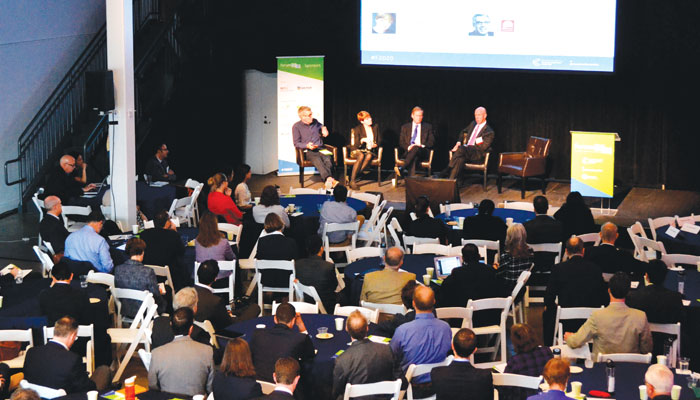Advocates look to bridge funding gaps
EDITOR’S NOTE: The renewable energy industry is on the opposite side of the political fence from the heating oil industry on vital issues such as taxing carbon, but wind and solar are important energy sources that will be in the mix along with petroleum for decades to come. Oil & Energy recently attended a clean energy event in Boston to learn about the challenges and opportunities facing renewable energy producers, electric utilities and utility regulators.
Solar and wind energy are quickly emerging as alternative sources of electric power, but the transition to renewables is complicated and challenging for all concerned: providers, utilities, regulators and policymakers. Hundreds of clean energy advocates and industry participants gathered in Boston recently for Forum 20/20, a look at innovation and the future of Cleantech, hosted by the Massachusetts Clean Energy Center.
Alicia Barton, CEO of the Clean Energy Center, told attendees that the Northeast region is the world’s leading center for clean energy innovation. The American Council for an Energy Efficient Economy has named Massachusetts the top state in the U.S. for energy efficiency for four consecutive years, and the Massachusetts Clean Energy Center 2014 Industry Report states that 88,000 people are working in clean energy in the state – a 10.5 increase from 2013.
Barton predicted that clean energy would someday be recognized as an economic engine as important as biotechnology or high tech. Massachusetts Clean Energy Center is focused on accelerating the success of clean energy companies by finding gaps in the commercialization process and giving companies the help they need, she said.
Utilities Face Stiff Challenges
The event featured several panel discussions, where leaders from industry, government and venture capital dissected the challenges and opportunities that lie ahead. In a panel entitled “The Utility of the Future,” five energy experts discussed the sweeping changes that are overtaking the electric power industry. They said utilities are struggling to juggle expectations around renewable energy, emissions reduction and consumer choice while adapting to new economic realities.
Philip Giudice, CEO of Ambri Inc., a developer of electricity storage solutions for the grid, cited the example of the Hawaiian Electric Co. (HECO), which has had to restrict private use of wind and solar power installations because the grid had become dangerously overwhelmed. Ratepayers have been choosing solar photovoltaics (SPV) to avoid HECO’s high rates and feeding their excess solar electricity into the grid, but the grid is not properly engineered to handle the heavy input from distributed generation (DG).
Traditional grids are one-way systems designed to distribute centrally generated power to end users, but utilities are now expected to re-engineer their systems to accommodate DG and net metering, so that customers can upload power they generate.
Companies like Ambri are developing new large-scale energy storage systems that would make DG from solar and wind more manageable by storing the energy for use later. Lacking storage, electricity must be used immediately or wasted.
Giudice said that very few utility executives are embracing the new energy models. Instead they speak of “utility death spirals” and a loss of easy financing due to reduced growth and cash flow. Utilities now have a huge opportunity to work out new solutions for the grid, but they do not yet have the necessary incentives to embrace new business models, he said.
David Malkin, Director of Government Affairs and Policy for GE Energy Management, said utilities are facing three major types of challenges: new regulations regarding cyber security, resiliency and cleaner power generation; a change in generation supply mix as natural gas and DG replace coal and nuclear; and changing investment dynamics based on destruction of ratepayer demand. Customers and policymakers alike expect utilities to equip customers to participate more actively through net metering and demand response, and the utilities have to decide whether to shoulder the responsibilities themselves or allow third parties to participate, he said. “The utility of the future will be defined by its capability in managing these challenges,” Malkin added.
Janet Besser, Vice President of Policy and Government Affairs for the New England Clean Energy Council (NECEC), said utilities need to adapt their cultures and business models, because customers are changing how they create and use electricity.
Regulators also need to change the regulatory frameworks to help utilities recover costs, compensate for generation and implement innovative solutions, according to Besser. Policy responsibilities are split between state and federal authorities, with the states regulating distribution and the feds managing transmission policies. She said federal transmission policy is essential, because it governs interstate transmission, such as how load reduction in Maine can benefit ratepayers in Connecticut.
Ambri’s Giudice said that a lack of federal energy policy inhibits utilities and other parties from making the necessary improvements, and GE’s Malkin said the U.S. Department of Energy (DOE) has a great opportunity to create new metrics for evaluating and guiding utility performance.
U.S. utilities and regulators can learn lessons from Germany, which has dramatically overhauled its electric policies to drive an increase in solar, wind and other renewables. Malkin called the German model “a failure,” saying that utilities are writing off billions of dollars in generation assets while consumers are paying 45 percent more for electricity. Germany’s policy and the implementation are both flawed, due to a lack of planning, he said, adding, “Hopefully we can learn some lessons from the failed policy in Germany.”
The good news about the German experiment is that it shows renewable energy can be used at utility scale, according to Besser. The German approach has been messy, but the U.S. can learn from it and figure out how to support innovation and enable utilities to recover costs, she said.
Lisa Frantzis, Senior Vice President for Strategy and Corporate Development at Advanced Energy Economy, said Massachusetts, New York and Hawaii have emerged as leaders who can drive new partnerships that show the way for the other states. Utilities need to stop resisting change and start sharing information with regulators and policymakers so they can develop policies that advance clean energy goals, she said.
Financial Innovation Is Needed
Another panel entitled “Charting CleanTech’s Future,” brought four experts together to discuss the opportunities and challenges ahead. Cheryl Martin, Acting Director of the U.S. Department of Energy’s (DOE) Advanced Research Projects Agency-Energy (ARPA-E) program, said clean energy has passed through its early “euphoric” times to a more balanced stage. The conversation about clean energy and the grid is dynamic and now involves the utilities themselves, who recognize that the old utility business model is under threat, she said.
ARPA-E provides funding to high-impact energy technologies that are too early for private-sector investment, including many clean energy pioneers, and Martin said that a lot of venture capital models don’t fit in the energy industry, so financial innovation is needed.
The panelists examined the role of state and federal policies in supporting clean energy technologies and suggested that the states have been better partners than the federal government. The DOE was crippled in 2011 by a scandal in which solar energy parts manufacturer Solyndra went bankrupt after receiving a $536 million DOE loan guarantee and a $25 million tax break from California.
John MacWilliams, Senior Advisor to the U.S. Secretary of Energy, said he was not surprised by the struggles of some clean energy firms. Clean energy’s trajectory reminds him of the biotech industry, which endured a succession of failures in the early going before gaining strength and being incorporated into big pharma. The Solyndra scandal bedeviled DOE, according to MacWilliams, but clean energy is now at a tipping point, and the department is coming out of its “defensive crouch.”
Paul Gaynor, CEO of First Wind, a Boston-based renewable power provider, said companies like his have to “pick their spots” to find supportive policymakers. First Wind is working with states like Massachusetts and Hawaii, where there is a commitment to advance renewable energy. “When you think about wind and solar subsidies, the conversation is anything but rational,” he said. “Our strategy is devoid of federal initiatives. It is all about the states. That is where the action is happening.” Providers like First Wind are bringing down the overall cost of the energy complex and selling lots of power to utilities, but members of Congress still talk about clean energy as a subsidized industry, Gaynor said.
The First Wind CEO pointed out that institutional capital is starting to flow into clean energy, which is helping to bring down the cost of technology and production, which reduces the cost of delivered energy. “The amount of manufacturing in the U.S. has tripled in the wind space, and the cost of capital has come down,” he added. He predicted that the cost of commercial scale renewable power would continue to decline.
The country needs bold leadership that recognizes the many economic benefits of clean energy and is committed to capitalizing on opportunities, Gaynor said. First Wind is now limited to building incremental wind projects based on incremental policy. “I’m not complaining, but that doesn’t solve the problem. We need to go deep and big,” he added. Gaynor said he hopes the next leaders of states like Massachusetts, Connecticut and Rhode Island will move aggressively on clean energy. “There is a great opportunity to save $1 billion a year in energy costs,” he said.
One of the biggest hurdles for an emerging clean energy company, according to ARPA-E’s Martin, is getting to the pilot plant stage, because capital needs can be in the tens of millions and the project is unlikely to make money in the near term.
There is a tremendous sense of urgency on climate change, according to MacWilliams. “Can we innovate fast enough and get the capital markets changed fast enough to deal with our goals on climate?” he asked. He said it is important to innovate with the installed base of fossil fuel generation too, not just the clean energy sources.





